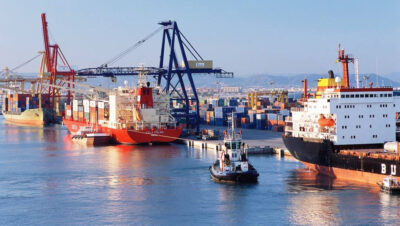>>REAL-TIME UPDATES IN THE WIRE. CLICK HERE<<<
China’s export growth slowed significantly in August amid weakening overseas demand, with shipments to most major economies weakening and exports to the US falling from a year earlier.
Exports rose 7.1% year over year to $314.9 billion in August, slowing from an 18% increase in July, and imports edged up 0.3% to $235.5 billion, decelerating from a 2% gain in the month prior.data from the General Administration of Customs showed on Wednesday.
The trade balance fell to $79.39 billion last month, compared to a record $101.26 billion in July and a consensus forecast of $92.7 billion. In yuan terms, China’s exports grew 11.8% in August from a year earlier, slowing from the 23.9% growth in the previous month, while imports grew by 4.6%, versus the 7.4% growth in the month before, showed the data. Trade surplus narrowed to 535.9 billion yuan from 682.69 billion yuan in the previous month.
In the first eight months of the year, China’s total imports and exports, in US dollar terms, reached $4.19 trillion, rising by 9.5% from a year ago, and that included $2.38 trillion of exports, up 13.5%, and $1.81 trillion of imports, up 4.6%, showed the data. Trade surplus reached $560.5 trillion yuan in the period, expanding by 56.7% from a year ago.
Weaker external demand and last year’s high base were the main factors behind slowing exports, Zheng Houcheng, director of the Yingda Securities Research Institute.
The JPMorgan Global Manufacturing Purchasing Managers’ Index, a global economic indicator compiled by S&P Global, fell for a third straight month in August to 50.3, the lowest in 26 months an sliding from 51.1 in July, Zheng noted, adding that the new orders index dropped further below 50.
The global manufacturing PMI recently released by the China Federation of Logistics also dropped for a third month in a row in August to 50.9, versus 51.2 in July.
Yuan depreciation will support future exports, Zheng noted, but the pace of export growth will remain under pressure in September, he cautioned.
Given the high base last year, the downturn in overseas economies, and the effect of higher export commodity prices, export growth is likely to slow further in September, said Wang Qing, chief macro analyst at Golden Credit Rating.
“China’s export growth rate will decline in fluctuations, with the figure going negative in some months of the fourth quarter,” Wang noted. “This means that steady growth in the second half of the year will rely more on domestic demand.”
By regions, China’s exports to the US fell by 3.8% on year in August, the weakest performance since April 2020 and slowing sharply by 14.7 percentage points from the previous month, showed the customs data. Shipments to the EU and Japan grew by 11.15 and 7.7%, respectively, slowing by 12.1 percentage points and 11.3 percentage points from the month before. Exports to the ASEAN countries surged by 25.1% on year, picking up by 22 percentage points.
By products, exports of labor intensive goods such as suitcases and shoes grew by 24% and 16.4%, respectively, in August from a year earlier, slowing significantly by 17.3 and 21.1 percentage points. Exports of apparels grew by 5%, slowing from 18.4% gain in July. Exports of textile products including masks fell by 0.3% on year, marking the first drop since March 2022.
Exports of mechanical and electrical products grew by 4.3% on year in August, slowing from the 13% growth in July, with exports of medical equipments falling 9.6%, exports of smartphone rising 21.5% and exports automobiles surging 65.2%. Exports of high-tech products fell by 3.9% in August from a year earlier.
Due to sluggish demand in the domestic market, China’s commodities imports remained weak. China’s crude oil imports reached 40.35 million tonnes in August, falling 9.4% from a year earlier, narrowing slightly from 9.5% drop in July, falling for the third consecutive month. cNatural gas imports reached 8.85 million tonnes, sliding 15.2% from a year earlier, and refined oil product imports reached about 1.89 million tonnes in August, sliding 35.4 from year earlier.

